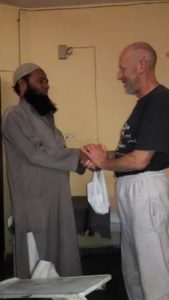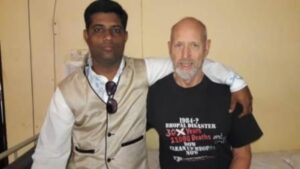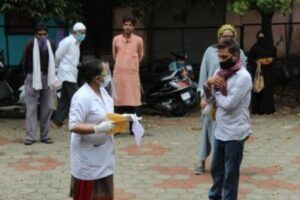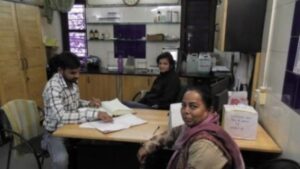We are delighted to share a report from one of the regular volunteers at the Sambhavna and Chingari clinics, Ian Jarvis. Ian is a physiotherapist who regularly travels to Bhopal to work with patients at both clinics. Here is his most recent report on his experiences in Bhopal:
Well, that’s another four months done. It was becoming very hot as I left from Delhi airport after a few days with my friends in Delhi.
Well, that was what I wrote four weeks ago, before the coronavirus changed everything. Here I am in early May having arrived back in the UK just a few days ago on a ‘repatriation flight’. It was only a week or so before my scheduled return that the Indian Government shut down the country and all international flights in or out were stopped. Simultaneously all public transport was discontinued, so even had I wanted to, I would have been unable to reach Delhi. Even private travel was restricted by city and state boundaries, preventing anyone from travelling unless they had some official form of permission. But let’s go back a little.

On the day I sent off the last update to the BMA in mid-January, we had a chaotic day at Chingari. The decorators had finished in our work room and some cleaning had been done on the Saturday. I had gone there to resume my usual Saturday routine, but I found there were paint spots all over the floor and much of the equipment was missing. Plus, the physiotherapist who had been working in the sensory room with the occupational therapist had moved in, as there were now two OTs. This involved a lot of re-organising of the space. Thankfully, this room was much larger than our previous one. It also contained all the equipment, which previously was mostly in the communal area. They were eventually able to fit me in and I was able to return to work. However, I was right in front of the door, so people almost fell over me as they entered! Still, good humour got us through the days.
After my final week working at Chingari I spent a few days visiting Harshit, an old friend, before returning to Bhopal to give my time to Sambhavna. I have been asked to comment on how I find Chingari as this is the second time I have worked there. My answer is to ask what the situation in Bhopal would be were it not there? I have three main thoughts on the subject:
1. Hundreds of children would be without professional help and their families without support.
2. Chingari has quietly changed the social attitude to disability. When I was first in Bhopal in 2011, there was a stigma to having a child with a disability. In many cases the father would simply leave and blame it on something the mother had done to deserve it. This has largely turned around and there is a much greater acceptance of disabilities, at least in these suburbs of Bhopal.
3. Now I see many more fathers attending with their child or children, providing the transport for them, or both. One man patiently arrives on his motor scooter bringing his twin sons who are now in their mid-20s but with severe mental health problems as well as some obvious physical deficiencies. There are occasionally couples who come together to shepherd their children.
Nothing is perfect and my perfect will be different to yours anyway, but those three things are huge changes that would not have happened had Chingari not been there since 2004.
*****
Before I began at Sambhavna, I had a few days holiday. Myself and my friend Thorsten, who have both volunteered at the clinics for several years, went to stay with Harshit in his village. We met Harshit some years previously as one of a growing band of Indian volunteers and helpers. He had passed through a few weeks ago, staying just overnight, when he came to Bhopal to sit an entrance exam for a course. He is a photographer and has worked on a variety of projects, including one with the village people of Gondwana. It may be because of those experiences that he is building himself a home on the edge of the jungle.
My friendship with Harshit is not relevant to my stories of the clinics, other than showing that if you come here and volunteer you might make all sorts of connections with other volunteers and locals which can lead to all sorts of adventures. It was interesting to visit whole villages without running water in their homes and no bathroom. In the villages it is common to cook with a fire, often without a chimney, even though most people could afford a gas hob and cylinders. Unfortunately, internal fires have been shown to cause early death, mostly of the women who cook, as well as congenital birth problems.
On my return to Sambhavna I found I would once again be working in the Observation Room, or “15 room” as it is referred to here, with my favourite nurse, Shabnam, who is also a skilled interpreter. On quiet days we have conversations on many different subjects, as well as sharing chai and samosas.
A side note on Samosa’s: the samosas here are much better than any I have had anywhere else outside India. They are made from scratch on the day, mostly in unhygienic conditions of the street stalls, and then immediately fried in deep and very hot oil before being sold and consumed. This makes the pastry crisp and tasty, unlike in the UK where it is always soft and sometimes soggy from travel via freezer and/or fridge. In other words, don’t judge samosas if your only experience of them is outside India!

It was nice to meet my friend Dr Usha again, especially as she said that she has missed me since my last visit. The doctor who has been here the longest, Dr ‘Jay’ Mritunjay, left a few weeks ago to work in Jabalpur in an Ayurveda hospital which is also being extended considerably. The replacement was Dr Rhaguram, from Kerala. I had trouble pronouncing his full name so he agreed I could call him ‘Ram’, a nickname that caught on with some of the other staff. He had been working in a family practice which, he told me, was very strict and if a patient said he or she could not do all the things advised by the doctor they would be shown the door. Sambhavna is very different, he noted, as most people can’t change their lifestyle nor remove themselves from the environment with all its pollution. You may have seen my first interview with him on Youtube or Facebook – the channel and page are both called “Bhopal Today” (with the space). Go and have a look if you haven’t already, it was an interesting chat containing a lot of information about Sambhavna. The direct link is:
The other Ayurveda doctor, Dr Roopa, left in mid-March. She and Jay are married so it was rather inevitable that, with two children, she would be leaving so the family will be together. The last thing she said to me was to invite me to go over to Jabalpur and visit them for a few days.
Coincidentally, Ram’s wife is also an Ayurveda doctor and will now take over Dr. Roopa’s patient list. Poor Ram was very busy as Roopa had left but his wife and family were still in Kerala, delayed by the acquisition of accommodation in Bhopal and the coronavirus scare and lockdown in Kerala. I am sure that he will be very grateful when they are able to be with him for more than one reason. I had expected to meet her before I left but because of the restrictions she has still not arrived in Bhopal.
When Covid-19 arrived, it became necessary to restructure how the clinic remained open so that it could both serve its patients and provide a safe-as-possible working environment for the staff. The first thing was to move the waiting area to the forecourt, which was fortunately very practical in Bhopal weather, though there was one thunderstorm which meant moving everyone to the meeting room. Some services were suspended, notably Panchakarma, gardening and medicine making. The nurses, Shabnam, Aziza and Beena, talk to the patients in the forecourt and discuss their needs. They take the books to the Registration Office where Nitesh, Shweta and Nargis work to access the full computer record for the doctor. Dr Ram is still living in the clinic and is the only one attending patients now. He sits in the Registration room where he sees each patient. This avoids people having to move about the building. The Pharmacy with Bhavesh, Kamal and Ajay is just the other side of the entrance, so prescriptions are taken by a nurse while the patient waits in the forecourt.

Meanwhile, the health worker team (see picture) continue to work. Chingari has lent two of its minibuses with drivers so they don’t have to go out on their motorbikes during this time. It also means they can take remedies and medicines to save patients having to travel. Biju has gone with them and is recording it with many pictures (which you can see on my Facebook page and elsewhere on the BMA website), as they do education and consultations.
I should add at this point that the cohort of Sambhavna patients, i.e. gas and water survivors, mostly sit in the high-risk category from what we know of this disease. Many are now elderly; some 60% have lung and respiratory issues; 50% have heart problems and there are other common co-morbidities. It is thus very important that the work at the clinic continues. Sathyu is still in every day, as are some of the other staff and researchers, and Ratna continues to keep an eye on the gardens as much as possible.

*****
As for my work, I’m often asked what I’m doing in Bhopal, treating backs and shoulders etc. What do they have to do with the gas or water after-effects? The answer is that these survivors have weakened immune systems, and many have respiratory and other issues. These conditions can cause accidents that, although they might not affect you or I, would affect those with underlying long-term weaknesses. Should we deny them treatment? I think not. Finally, I want to remind all readers that I am just a fly-by-night. The real work is being done day-in and day-out by the Sambhavna staff.
If you would like to hear the story of my final week and the ups and downs of repatriation flights, you can see my final video diary post using the link below. You can also browse other videos on the channel and pictures on my Facebook page, both of which are called ‘Bhopal Today’:


